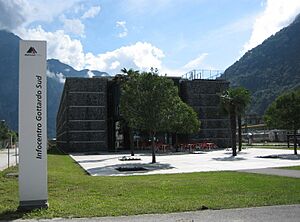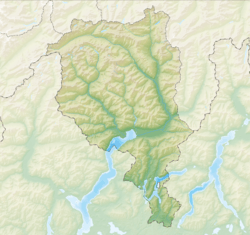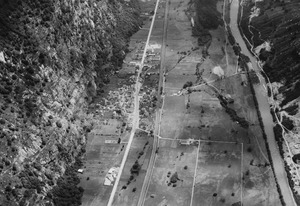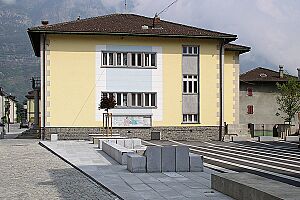Pollegio facts for kids
Quick facts for kids
Pollegio
|
||
|---|---|---|

Pollegio village
|
||
|
||
| Country | Switzerland | |
| Canton | Ticino | |
| District | Leventina | |
| Area | ||
| • Total | 5.99 km2 (2.31 sq mi) | |
| Elevation | 298 m (978 ft) | |
| Population
(Dec 2020 )
|
||
| • Total | 800 | |
| • Density | 134/km2 (346/sq mi) | |
| Postal code |
6742
|
|
| Surrounded by | Biasca, Bodio, Personico, Semione | |
Pollegio (called Puléisg in the local language) is a small town in Switzerland. It's located in the Ticino region, in a valley called Leventina. The Ticino River flows through this valley.
Contents
Pollegio's Past
Pollegio was first mentioned in old writings around 1237. It was known by a German name, Klösterli, but that name isn't used anymore. In the Middle Ages, Pollegio was part of a larger community called the Vicinanza of Giornico.
Early Days of Pollegio
Long ago, Pollegio had two main communities: one in the mountains and one in the valley. The valley part was connected to the larger Commune of Leventina. In 945, the area was given to the Canons of the Cathedral of Milan. Later, in 1403, it became part of Uri, a Swiss canton.
Between 1210 and 1236, a special place called a "hospice" was built in Pollegio. It was a place for travelers to rest. A religious group called the Humiliati ran it. Later, it became a "monastery."
Important battles happened near Pollegio. In 1422, Swiss soldiers met here before the Battle of Arbedo. They even sent a message of war to the Duke of Milan from Pollegio! In 1478, after the Battle of Giornico, soldiers who died were buried in Pollegio. A church, the Church of the Santissimi Martiri Innocenti (Most Holy Innocent Martyrs), was built to remember them. This church was later renovated many times.
For a long time, Pollegio's church was part of the Bodio parish. But in 1602, Pollegio finally became its own independent parish.
The Pollegio School for Priests
In 1622, a special school called the Seminary of Pollegio was officially started. It used money from the old Humiliati monastery. This school was for young men who wanted to become priests.
The school had to close sometimes because of floods from the Brenno and Ticino rivers. It also closed for a while between 1787 and 1796. In 1851, soldiers closed the Seminary, and the mayor of Pollegio took charge of it.
Teachers and Students
The Seminary was led by a rector from a religious group called the Oblates of Saint Ambrose and Charles. Many students came from the local valleys, like Leventina and Blenio. Some students even came from other Swiss cantons, like Uri, to learn Italian.
School Rules and Lessons
The school year started in November and ended in July. Students had holidays on Sunday and Thursday afternoons. A special rule was that students had to speak Latin most of the time, except during playtime and after dinner. They studied grammar and read books by famous writers like Cicero.
School Becomes Public
In 1852, the government took over the Seminary, making it a public school. In 1873, it became a science school. The boys' section later moved to Locarno, but the girls' section stayed in Pollegio until 1881. Later, it became a school for future priests again, but that part moved to Lugano in 1919. A famous student from this school was Stefano Franscini.
Local Families and Community Assets
The "Patricianship" refers to families who originally came from Pollegio. These families used to manage the community's shared resources, like forests, grasslands, and mountains. They were also in charge of keeping roads, bridges, and fountains in good condition.
Pollegio in the 1900s

For a long time, Pollegio's economy was based on farming and raising animals. In the 1800s, people also started mining granite. In 1999, a huge project began near Pollegio: the construction of the new Gotthard Base Tunnel. An information center was even set up there for visitors to learn about the tunnel.
Pollegio's Location
Pollegio covers an area of about 5.89 square kilometers (2.27 square miles). A lot of this land is covered by forests (about 67%). Some land is used for farming (about 16%), and some has buildings and roads (about 10%). There are also rivers and some areas that are too rocky for plants to grow.
The town of Pollegio includes the main village and a smaller area called Pasquerio.
Pollegio's Coat of Arms
The coat of arms for Pollegio shows a red cardinal's hat and three red stars on a gold background.
People of Pollegio
Pollegio has a population of about 861 people as of 2023. Many people in Pollegio speak Italian (about 90%). Some also speak Portuguese or German.
In 2009, there were 51 children under 9 years old and 87 teenagers between 10 and 19. Most of the adult population is between 20 and 59 years old.
The number of people living in Pollegio has changed over time:
| year | population |
|---|---|
| 1567 | 50 Hearths |
| 1602 | 316 |
| 1745 | 279 |
| 1850 | 468 |
| 1900 | 531 |
| 1950 | 483 |
| 2000 | 723 |
Pollegio's Economy

In 2005, there were 14 people working in farming. About 308 people worked in manufacturing and construction. Another 73 people worked in services like shops or offices. Many people who live in Pollegio travel to other towns for work.
Religion in Pollegio
Most people in Pollegio are Roman Catholic (about 87%). A small number belong to the Swiss Reformed Church.
Famous People from Pollegio
Luigi Imperatori (1844–1900) was born in Pollegio. He was a very important teacher and religious scholar in the Ticino region. He was also the first director of the main teaching school in Canton Ticino.
Education in Pollegio
In Pollegio, many adults (aged 25-64) have finished high school or gone on to college.
In 2009, there were 116 students in Pollegio.
- 14 children were in kindergarten.
- 37 students attended primary school.
- 27 students were in middle school.
- Some students were in programs to prepare for higher education or vocational jobs.
- There were also students in professional programs for fields like engineering or nursing.
About 56 students from Pollegio went to schools in other towns.
Images for kids
See also
 In Spanish: Pollegio para niños
In Spanish: Pollegio para niños











